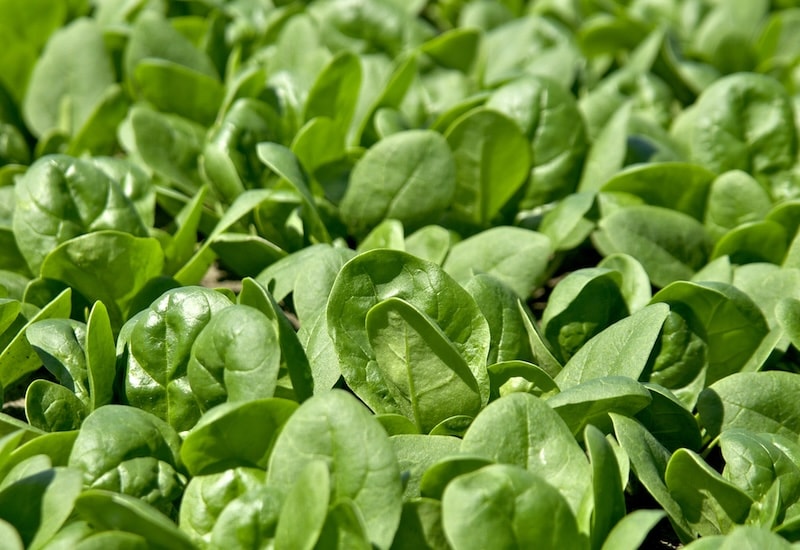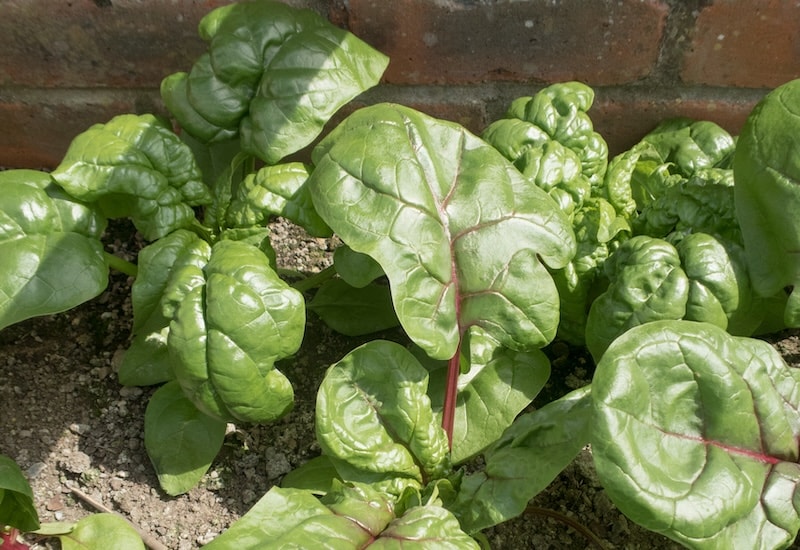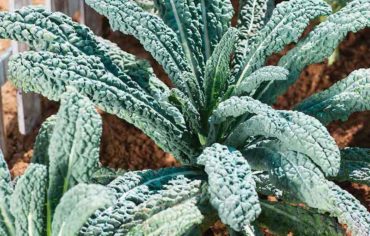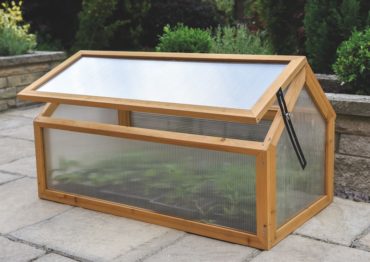Spinach is a versatile vegetable that is quick and easy to grow. If you sow the seeds little and often you’ll have a steady supply of nutritious leaves for most of the year. A compact crop that prefers light shade in summer, it’s a great way to fill gaps in your veg plot or underplant taller vegetables. It’s also good for container-growing or small space gardens. We asked experienced allotment grower Lee Senior for his advice on growing spinach. Here are his top tips.
Browse our full range of spinach seeds for inspiration.
Best spinach varieties to try
- Spinach ‘Santa Cruz’ F1’ is my favourite variety. It has good resistance to downy mildew but, even better, it’s slow to bolt. This is largely due to it being a slower growing variety. A further bonus is that the leaf stems are tender too.
- Mustard Spinach F1 ‘Comred’ is very speedy! It matures in 28 days if you intend to harvest it as baby leaf spinach. As well as being quick, ‘Comred’ has an attractive purple-red leaf colour and a tantalising hint of mustard flavour. It’s a high yielding variety that punches above its weight.
- Spinach F1 ‘Rubino’ has attractive red veined leaves. Its mild, sweet flavour makes it ideal for stir fries and salads. Particularly suited for growing and treating as baby spinach, it’s ready to crop between 4-6 weeks.
- Perpetual Spinach (leaf beet) is a real all-rounder. It’s adaptable, reliable and will cope with drier soils too. A big plus is that it’s less prone to bolting than some varieties. Perpetual spinach is suitable for sowing in spring and late summer and will crop repeatedly if cut regularly.
In general, flat leaf varieties of spinach cope a little better with warmer conditions than savoy varieties.
How and when to sow spinach seeds

Spinach ‘Santa Cruz’ has rounded, medium green leaves and tender stems
Image: Spinach ‘Santa Cruz’ F1 from Suttons
It’s possible to successfully sow spinach from seed for around nine months of the year using a combination of indoor and outdoor sowings. To ensure a regular supply of leaves, sow the seed every 3-4 weeks, either indoors or outdoors, depending on the time of year, while avoiding mid-summer.
Indoors, spinach seeds can be sown from late January to late April and then again from October through to early November. I use a heated propagator or a warm windowsill to germinate the seeds at temperatures of 10C – 15C. Root modules help to minimise root disturbance, which spinach dislikes. From mid-March onwards, there’s usually enough warmth in a cold greenhouse until the outdoor sowing season starts.
One quirky point about growing spinach is that indoor seed sowing isn’t generally the preferred or most successful method. While it can be useful for extending the cropping season at both ends of the year, failure rates can be noticeable and transplants are more prone to bolting.
The best and most reliable way to sow spinach seeds is directly outside where they are to grow, avoiding root disturbance. After germination, simply thin out the surplus seedlings. The best time of year for outdoor direct sowing is in spring (from mid-April to the end of May) and summer (from early August to the end of September).
- Sow the seeds approximately 2.5cm (1inch) deep in a prepared seed drill. Remove all pernicious weeds and try to make sure the soil is in a friable condition.
- Set your rows 30cm apart for baby spinach or 40-50cm for longer-term plants. Admittedly these are generous distances but I’ve found over the years this allows for a better airflow which minimises the risk of cultivation problems.
- Pre-water the drill if conditions are dry.
- Cover the seed with fine soil or compost.
- Germination takes between 10-21 days depending on the conditions.
- Make sure the soil doesn’t dry out before and also after germination.
- I like to thin my plants to a spacing of 15-20cm apart.
Where to grow spinach

Spinach F1 ‘Comred’ has a gentle, mustard-like taste, ideal for salads
Image: Spinach F1 ‘Comred’ seeds from Suttons
Both annual spinach and perpetual spinach generally prefer the same conditions – light or dappled shade rather than full sun. Anywhere that’s sheltered from the heat of the midday summer sun will give the best chance of success. A fertile soil containing copious amounts of organic matter and humus content is essential. This helps retain moisture and give the plants much needed nutrients.
Spinach can also be successful in large containers containing plenty of leafmould and well-rotted compost. The good thing about using containers is they can be moved to shadier locations to escape the sun. However, you might need to water twice a day in hot weather.
Spinach makes a useful catch crop on the allotment, temporarily filling gaps between larger plants which will cast some useful shade. Also planting alongside tall plants such as sweet corn and runner beans can help for the same reason.
How to care for spinach

‘New Zealand’ Spinach is easy to grow, even for beginners
Image: Spinach ‘New Zealand’ seeds from Suttons
The two key requirements for spinach are plenty of moisture and a temperature that isn’t too hot. Water the plants daily in dry weather and choose cooler, shadier parts of your allotment to grow them. The ideal growing temperature is 13C – 18C.
The prolonged intense heat of the midday summer sun can spell bad news for spinach and is likely to lead to poor results. If the weather turns hot, consider affixing some temporary shade over your plants to shield them from the heat. The best tactic is to avoid sowing the seed over the main part of the summer.
The main problems besetting spinach are bolting (running to seed), downy mildew and also aphids. The causes of plants bolting are heat-related stress, dryness at the roots and erratic watering. Some varieties are also more susceptible to bolting than others.
Downy mildew can just about be eliminated by choosing a resistant variety or employing good garden husbandry. Good airflow is key, so remove any yellow outer leaves to improve airflow, and keep the leaves dry while watering the roots of your plants.
Aphids are more likely to strike when the plants are stressed due to drought or heat-related issues, so keeping the plants strong and healthy is the best defence.
How and when to harvest spinach

Spinach ‘Perpetual’ produces succulent, prolific and nutritious leaves
Image: Spinach ‘Perpetual’ (Spinach Beet) Organic Seeds from Suttons
Spinach can be harvested almost all year round with careful planning. Regular successional sowings every 3-4 weeks (avoiding summer) will keep a regular supply of young leaves going.
Use the thinnings as baby spinach, allowing the others extra space they need to grow on as larger plants. Mature plants can be cropped for several months and will come again with extra flushes of leaves. I tend to harvest by snapping the leaves using my finger and thumb, leaving the centre of the plant intact. You can also use a knife or scissors to cut the leaves near the base if you prefer.
Spinach is a fast-growing cut-and-come-again crop that provides a steady supply of nutrition-packed leaves. Whether you like yours fresh, steamed, stir-fried, blended into pesto or blitzed into smoothies – it’s a wonderful addition to any garden. For more of Lee’s practical, hands-on, vegetable growing tips, head over to his monthly allotment pages and follow him at @lee_senior_gardening.
Image: Spinach F1 ‘Rubino’ Seeds





